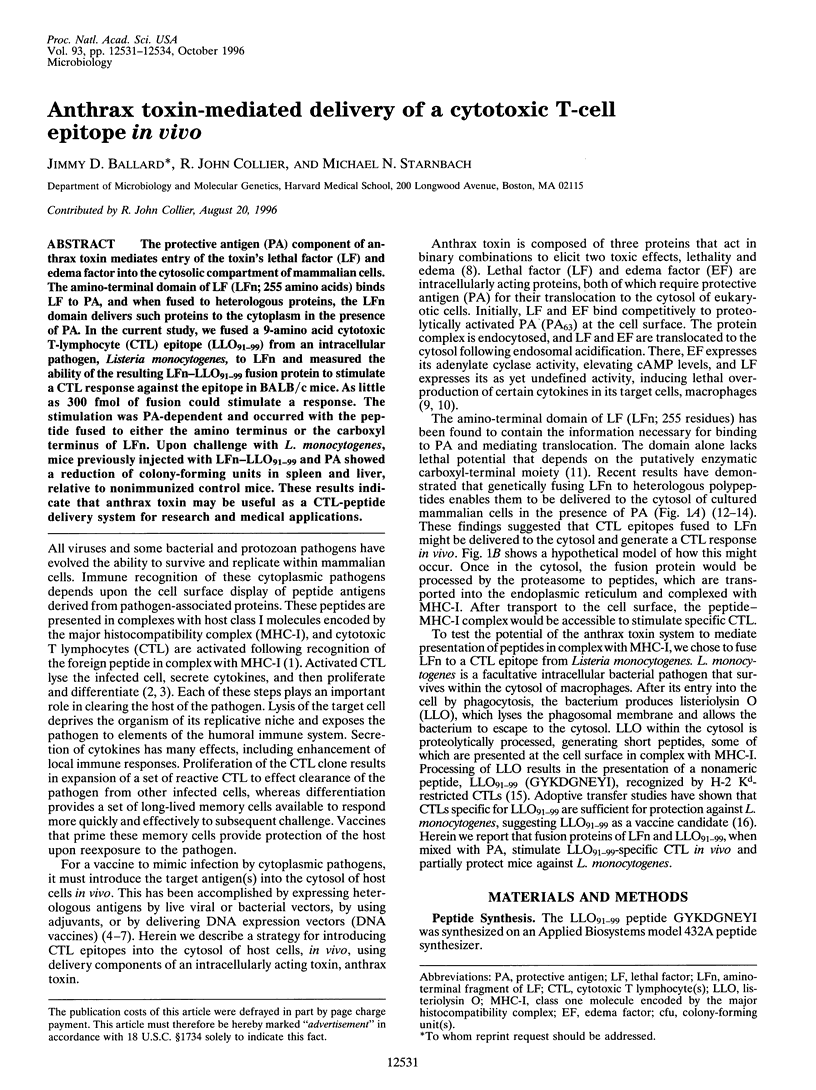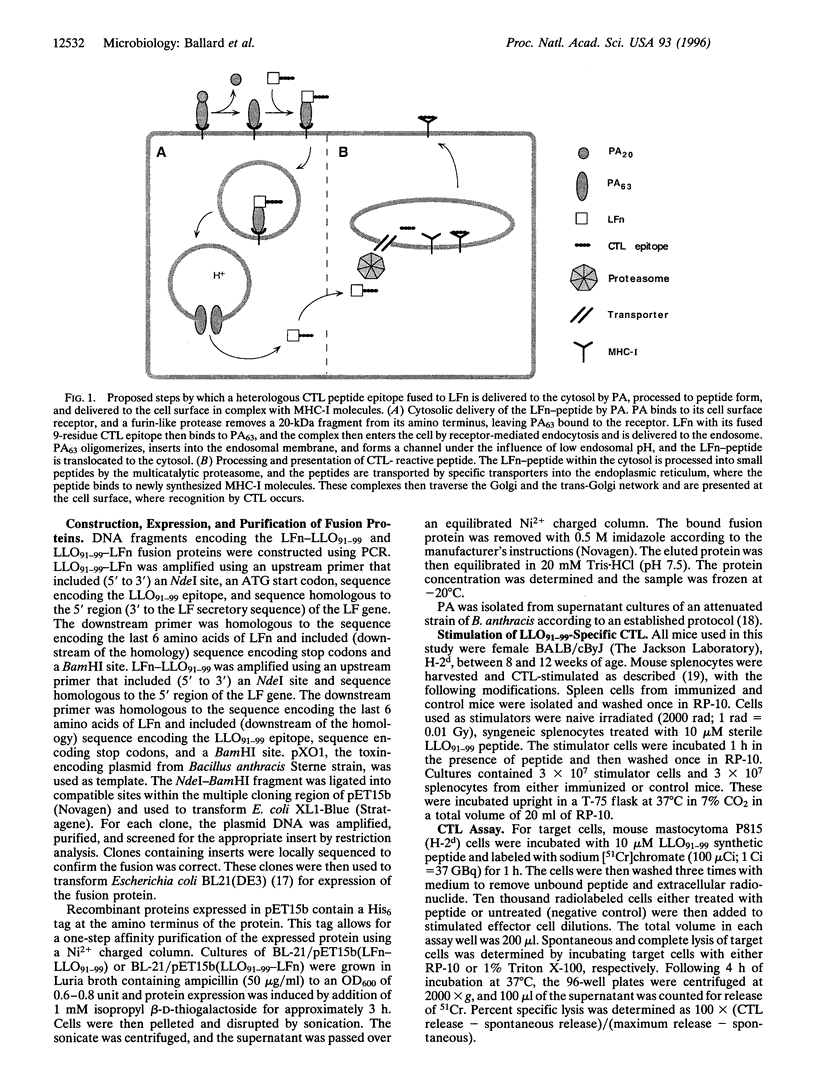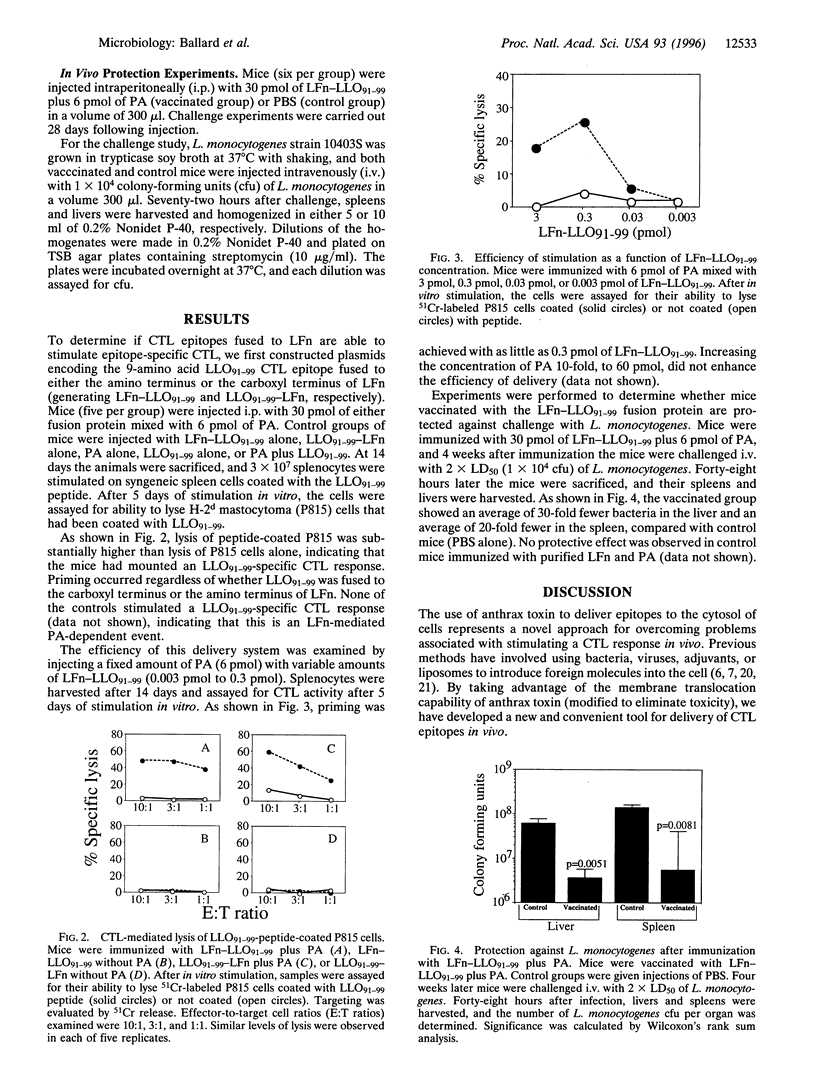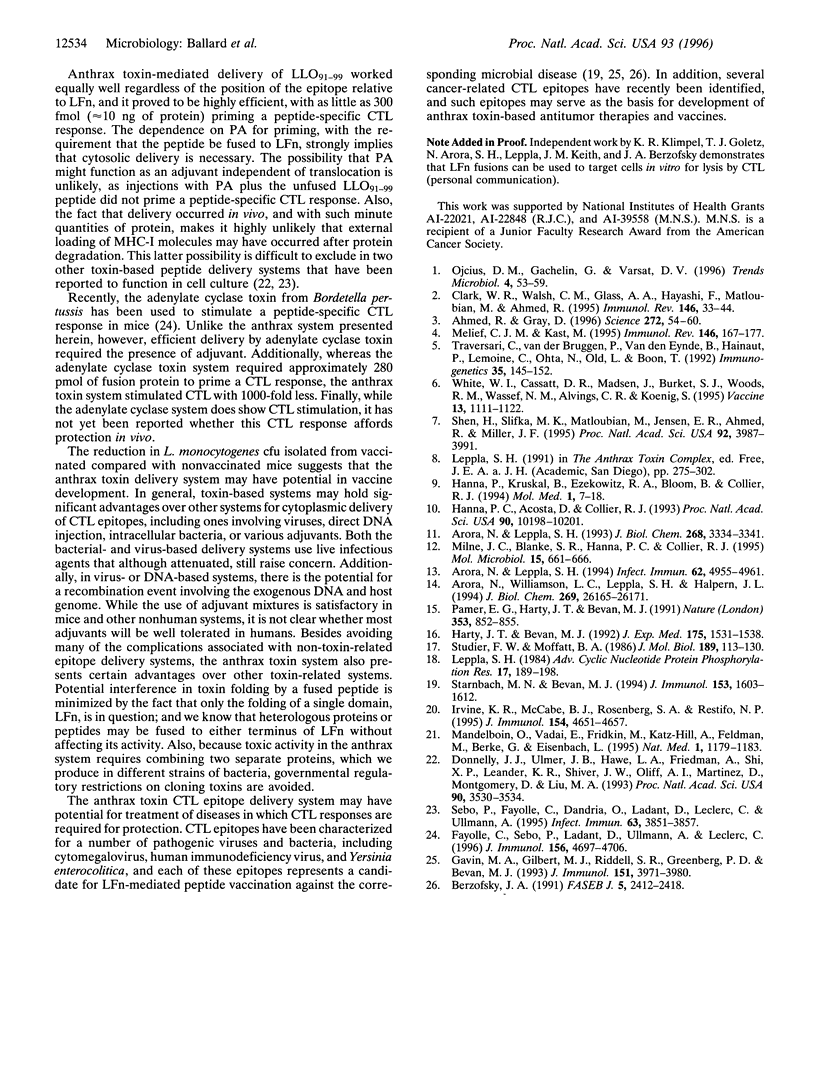Abstract
The protective antigen (PA) component of anthrax toxin mediates entry of the toxin's lethal factor (LF) and edema factor into the cytosolic compartment of mammalian cells. The amino-terminal domain of LF (LFn; 255 amino acids) binds LF to PA, and when fused to heterologous proteins, the LFn domain delivers such proteins to the cytoplasm in the presence of PA. In the current study, we fused a 9-amino acid cytotoxic T-lymphocyte (CTL) epitope (LLO91-99) from an intracellular pathogen, Listeria monocytogenes, to LFn and measured the ability of the resulting LFn-LLO91-99 fusion protein to stimulate a CTL response against the epitope in BALB/c mice. As little as 300 fmol of fusion could stimulate a response. The stimulation was PA-dependent and occurred with the peptide fused to either the amino terminus or the carboxyl terminus of LFn. Upon challenge with L. monocytogenes, mice previously injected with LFn-LLO91-99 and PA showed a reduction of colony-forming units in spleen and liver, relative to nonimmunized control mice. These results indicate that anthrax toxin may be useful as a CTL-peptide delivery system for research and medical applications.
Full text
PDF



Images in this article
Selected References
These references are in PubMed. This may not be the complete list of references from this article.
- Ahmed R., Gray D. Immunological memory and protective immunity: understanding their relation. Science. 1996 Apr 5;272(5258):54–60. doi: 10.1126/science.272.5258.54. [DOI] [PubMed] [Google Scholar]
- Arora N., Leppla S. H. Fusions of anthrax toxin lethal factor with shiga toxin and diphtheria toxin enzymatic domains are toxic to mammalian cells. Infect Immun. 1994 Nov;62(11):4955–4961. doi: 10.1128/iai.62.11.4955-4961.1994. [DOI] [PMC free article] [PubMed] [Google Scholar]
- Arora N., Leppla S. H. Residues 1-254 of anthrax toxin lethal factor are sufficient to cause cellular uptake of fused polypeptides. J Biol Chem. 1993 Feb 15;268(5):3334–3341. [PubMed] [Google Scholar]
- Arora N., Williamson L. C., Leppla S. H., Halpern J. L. Cytotoxic effects of a chimeric protein consisting of tetanus toxin light chain and anthrax toxin lethal factor in non-neuronal cells. J Biol Chem. 1994 Oct 21;269(42):26165–26171. [PubMed] [Google Scholar]
- Berzofsky J. A. Development of artificial vaccines against HIV using defined epitopes. FASEB J. 1991 Jul;5(10):2412–2418. doi: 10.1096/fasebj.5.10.1712327. [DOI] [PubMed] [Google Scholar]
- Clark W. R., Walsh C. M., Glass A. A., Hayashi F., Matloubian M., Ahmed R. Molecular pathways of CTL-mediated cytotoxicity. Immunol Rev. 1995 Aug;146:33–44. doi: 10.1111/j.1600-065x.1995.tb00682.x. [DOI] [PubMed] [Google Scholar]
- Donnelly J. J., Ulmer J. B., Hawe L. A., Friedman A., Shi X. P., Leander K. R., Shiver J. W., Oliff A. I., Martinez D., Montgomery D. Targeted delivery of peptide epitopes to class I major histocompatibility molecules by a modified Pseudomonas exotoxin. Proc Natl Acad Sci U S A. 1993 Apr 15;90(8):3530–3534. doi: 10.1073/pnas.90.8.3530. [DOI] [PMC free article] [PubMed] [Google Scholar]
- Fayolle C., Sebo P., Ladant D., Ullmann A., Leclerc C. In vivo induction of CTL responses by recombinant adenylate cyclase of Bordetella pertussis carrying viral CD8+ T cell epitopes. J Immunol. 1996 Jun 15;156(12):4697–4706. [PubMed] [Google Scholar]
- Gavin M. A., Gilbert M. J., Riddell S. R., Greenberg P. D., Bevan M. J. Alkali hydrolysis of recombinant proteins allows for the rapid identification of class I MHC-restricted CTL epitopes. J Immunol. 1993 Oct 15;151(8):3971–3980. [PubMed] [Google Scholar]
- Hanna P. C., Acosta D., Collier R. J. On the role of macrophages in anthrax. Proc Natl Acad Sci U S A. 1993 Nov 1;90(21):10198–10201. doi: 10.1073/pnas.90.21.10198. [DOI] [PMC free article] [PubMed] [Google Scholar]
- Hanna P. C., Kruskal B. A., Ezekowitz R. A., Bloom B. R., Collier R. J. Role of macrophage oxidative burst in the action of anthrax lethal toxin. Mol Med. 1994 Nov;1(1):7–18. [PMC free article] [PubMed] [Google Scholar]
- Harty J. T., Bevan M. J. CD8+ T cells specific for a single nonamer epitope of Listeria monocytogenes are protective in vivo. J Exp Med. 1992 Jun 1;175(6):1531–1538. doi: 10.1084/jem.175.6.1531. [DOI] [PMC free article] [PubMed] [Google Scholar]
- Irvine K. R., McCabe B. J., Rosenberg S. A., Restifo N. P. Synthetic oligonucleotide expressed by a recombinant vaccinia virus elicits therapeutic CTL. J Immunol. 1995 May 1;154(9):4651–4657. [PMC free article] [PubMed] [Google Scholar]
- Leppla S. H. Bacillus anthracis calmodulin-dependent adenylate cyclase: chemical and enzymatic properties and interactions with eucaryotic cells. Adv Cyclic Nucleotide Protein Phosphorylation Res. 1984;17:189–198. [PubMed] [Google Scholar]
- Mandelboim O., Vadai E., Fridkin M., Katz-Hillel A., Feldman M., Berke G., Eisenbach L. Regression of established murine carcinoma metastases following vaccination with tumour-associated antigen peptides. Nat Med. 1995 Nov;1(11):1179–1183. doi: 10.1038/nm1195-1179. [DOI] [PubMed] [Google Scholar]
- Melief C. J., Kast W. M. T-cell immunotherapy of tumors by adoptive transfer of cytotoxic T lymphocytes and by vaccination with minimal essential epitopes. Immunol Rev. 1995 Jun;145:167–177. doi: 10.1111/j.1600-065x.1995.tb00081.x. [DOI] [PubMed] [Google Scholar]
- Milne J. C., Blanke S. R., Hanna P. C., Collier R. J. Protective antigen-binding domain of anthrax lethal factor mediates translocation of a heterologous protein fused to its amino- or carboxy-terminus. Mol Microbiol. 1995 Feb;15(4):661–666. doi: 10.1111/j.1365-2958.1995.tb02375.x. [DOI] [PubMed] [Google Scholar]
- Ojcius D. M., Gachelin G., Dautry-Varsat A. Presentation of antigens derived from microorganisms residing in host-cell vacuoles. Trends Microbiol. 1996 Feb;4(2):53–59. doi: 10.1016/0966-842X(96)81511-3. [DOI] [PubMed] [Google Scholar]
- Pamer E. G., Harty J. T., Bevan M. J. Precise prediction of a dominant class I MHC-restricted epitope of Listeria monocytogenes. Nature. 1991 Oct 31;353(6347):852–855. doi: 10.1038/353852a0. [DOI] [PMC free article] [PubMed] [Google Scholar]
- Sebo P., Fayolle C., d'Andria O., Ladant D., Leclerc C., Ullmann A. Cell-invasive activity of epitope-tagged adenylate cyclase of Bordetella pertussis allows in vitro presentation of a foreign epitope to CD8+ cytotoxic T cells. Infect Immun. 1995 Oct;63(10):3851–3857. doi: 10.1128/iai.63.10.3851-3857.1995. [DOI] [PMC free article] [PubMed] [Google Scholar]
- Shen H., Slifka M. K., Matloubian M., Jensen E. R., Ahmed R., Miller J. F. Recombinant Listeria monocytogenes as a live vaccine vehicle for the induction of protective anti-viral cell-mediated immunity. Proc Natl Acad Sci U S A. 1995 Apr 25;92(9):3987–3991. doi: 10.1073/pnas.92.9.3987. [DOI] [PMC free article] [PubMed] [Google Scholar]
- Starnbach M. N., Bevan M. J. Cells infected with Yersinia present an epitope to class I MHC-restricted CTL. J Immunol. 1994 Aug 15;153(4):1603–1612. [PMC free article] [PubMed] [Google Scholar]
- Studier F. W., Moffatt B. A. Use of bacteriophage T7 RNA polymerase to direct selective high-level expression of cloned genes. J Mol Biol. 1986 May 5;189(1):113–130. doi: 10.1016/0022-2836(86)90385-2. [DOI] [PubMed] [Google Scholar]
- Traversari C., van der Bruggen P., Van den Eynde B., Hainaut P., Lemoine C., Ohta N., Old L., Boon T. Transfection and expression of a gene coding for a human melanoma antigen recognized by autologous cytolytic T lymphocytes. Immunogenetics. 1992;35(3):145–152. doi: 10.1007/BF00185107. [DOI] [PubMed] [Google Scholar]
- White W. I., Cassatt D. R., Madsen J., Burke S. J., Woods R. M., Wassef N. M., Alving C. R., Koenig S. Antibody and cytotoxic T-lymphocyte responses to a single liposome-associated peptide antigen. Vaccine. 1995 Aug;13(12):1111–1122. doi: 10.1016/0264-410x(94)00058-u. [DOI] [PubMed] [Google Scholar]



